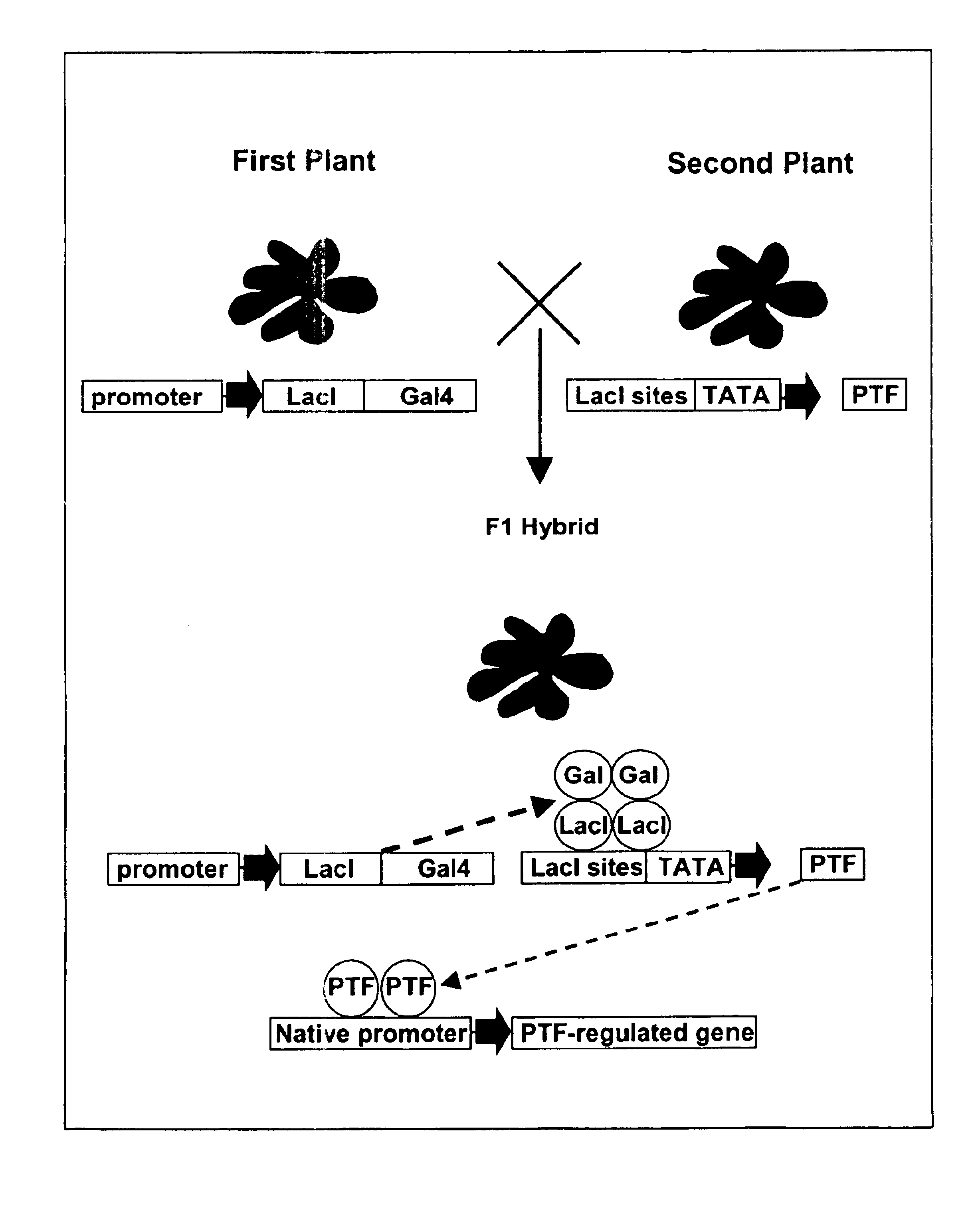Genetic trait breeding method
a genetic trait and breeding method technology, applied in the field of plant molecular biology, can solve the problems of limiting what can be achieved by breeding, limiting the number of new sources of genetic diversity, and traditional breeding proving rather ineffective in improving many polygenic traits
- Summary
- Abstract
- Description
- Claims
- Application Information
AI Technical Summary
Benefits of technology
Problems solved by technology
Method used
Image
Examples
example 1
Cloning of Promoters in Donor Vector
[0065]The plasmid vector pMEN020 was the vector used for donor and receptor vector construction. The pMEN020 plasmid construct is a binary cloning vector that contains both E. coli and Agrobacterium tumefaciens origins of DNA replication but no vir genes encoding proteins essential for the transfer and integration of the target gene inserted in the T-DNA region. PMEN020 requires the trfA gene product to replicate in Agrobacterium. The strain of Agrobacterium containing this trfA gene is called the ABI strain and is described in U.S. Pat. Nos. 5,773,701 and 5,773,696. This cloning vector serves as an E. coli—Agrobacterium tumefaciens shuttle vector. All of the cloning steps are carried out in E. coli before the vector is introduced into ABI strain of Agrobacterium tumefaciens.
[0066]Two different sets of constructs, which are based on bacterial DNA binding proteins LexA and LacI, respectively, were prepared. For the LexA system, the construct was p...
example 2
Construction of Receptor Vector
[0075]The receptor vector includes a corresponding binding region for the transactivator factor prepared above, in this case a LexA or LacI binding site, and a gene of interest, such as a transcription factor.
[0076]Two versions of the cloning vector will be built, one each for Lexa and LacI, respectively. For the Lexa version, eight copies of the Lexa binding site and the 35S minimal promoter will be cloned upstream of the E9 terminator. To this end, two fragments will be generated and then fused together by overlap PCR. The first fragment will be generated by primers O16417 (SEQ ID No. 15): GGCCCAAGCTTACATATCCATATCTAATCTTACCT and O11723, using the lexA_OP construct (described in the previous section) as template. The second will be generated by primers O11721 and O16416 (SEQ ID No. 16): CTAGAGGATCCGGTACGAGGCCTGTCTA, using pMEN20 as template. The two PCR products can be assembled together by PCR using primers O16417 and O16416. Note that HindIII recogn...
example 3
Transformation of Tomatoes
[0079]Tomato transformations are performed using the following procedure. Tomato seeds are sterilized in 50% bleach solution for 20-30 minutes and rinsed at least 3 times with sterile water. The seed are placed in magenta jars that contain the following media: 1× MS Salts, 1× Gamborg's Vitamins, 2% sucrose, and 0.8% phytagar. The seeds are germinated for 7-10 days at 25° C. with 16 hours of light. Agrobacterium from glycerol stock is inoculated into 5 ml of LB or YEP with the appropriate antibiotics, and the culture grown at 28° C. overnight with shaking at 250 rpm. When the optimal OD600 is reached (between 1.0 and 1.5), the bacteria are spun down and resuspended in liquid germination media to a concentration of 0.2 OD600. The cotyledons from 7-10 days old seedlings are cut into 0.5 cm pieces, and transferred to a co-cultivation plate with (D1-) media containing the following: 1× MS salts, 1× Gamborg's Vitamins, 3% glucose, 1 mg / L zeatin, 0.8% (w / v) phytag...
PUM
 Login to View More
Login to View More Abstract
Description
Claims
Application Information
 Login to View More
Login to View More - R&D
- Intellectual Property
- Life Sciences
- Materials
- Tech Scout
- Unparalleled Data Quality
- Higher Quality Content
- 60% Fewer Hallucinations
Browse by: Latest US Patents, China's latest patents, Technical Efficacy Thesaurus, Application Domain, Technology Topic, Popular Technical Reports.
© 2025 PatSnap. All rights reserved.Legal|Privacy policy|Modern Slavery Act Transparency Statement|Sitemap|About US| Contact US: help@patsnap.com

